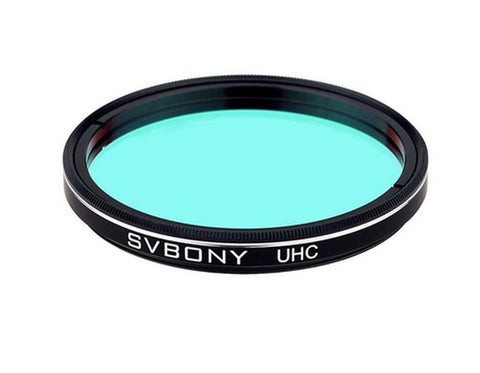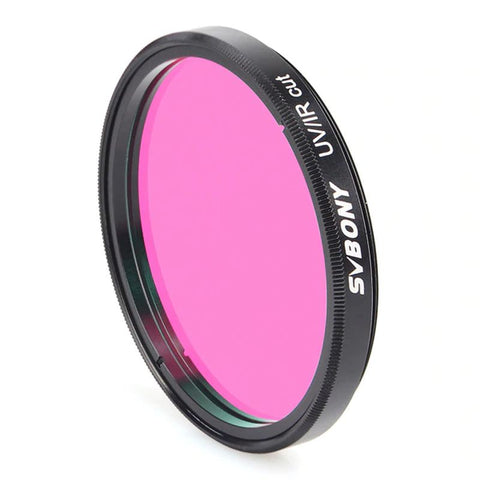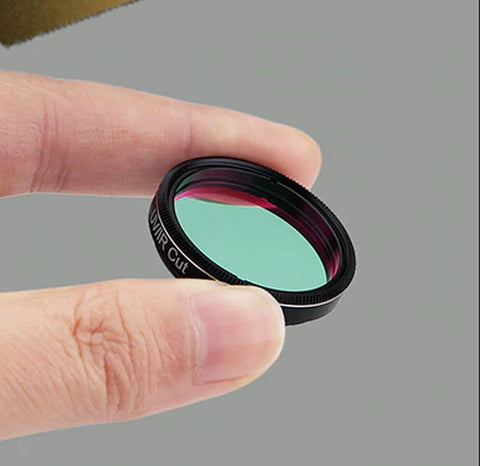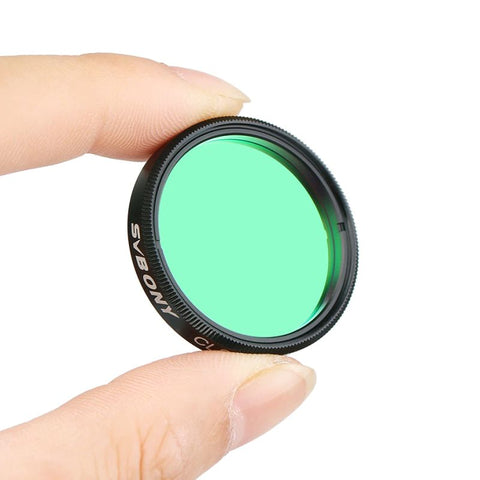Coloured Filter 1.25"
Coloured Filters
These general purpose coloured filters can be used to bring out certain features in your target, such as Lunar seas, Jupiter's bands and Mars' dust storms.
These filters are threaded for 1.25" eyepieces.
Light Red - Wratten #23A
The Light Red Filter is another great filter for use on Mars, Jupiter, and Saturn, but because of lowered light transmission, it may not perform well for 6"; and smaller telescopes. It carries out many of the same functions as the #21 and the #15, but with more contrast, bringing out marginally defined blue-green surface detail.
The filter is ideal for viewing the polar ice caps and surface features of Mars. It brings out yellow dust clouds and darkens Maria, oases and canal markings. On Jupiter and Saturn, this filter is useful for studying blue clouds.
The filter also increases contrast between Mercury and the bright blue sky during daylight observations or during twilight, when the planet is near the horizon. On Venus, it occasionally reveals deformations of the terminator. For comets the filter improves definition of the dust tail.
Yellow - Wratten #12
The Yellow Filter increases the contrast of blue and green areas on Mars, thus darkening the Maria, oases and canal markings, while lightening the orange-hued desert regions. It sharpens boundaries of yellow dust clouds and the blue clouds in the Martian atmosphere and is thus a favorite for viewing the red planet.
The yellow filter contrasts strongly with blue-colored features on Jupiter and Saturn, thus enhancing red and orange features of the belts and the zones. It darkens atmospheric currents containing low-hue blue tones and may be used for studies of the polar regions on these planets. Like the other yellow-tinged filters, it improves detail in larger telescopes in Uranus and Neptune while with Venus it reveals otherwise low-contrast features. This filter also enhances definition in comet tails and is useful in increasing the contrast of lunar features in telescopes of 6" aperture and larger.
Light Green - Wratten #56
This filter is excellent for the observation of Martian polar ice caps and for the dust storms on the planet's surface, strongly increasing their contrast. It also brings out the red and blue regions such as the Great Red Spot on Jupiter in contrast to the lighter portions. It is useful for observing the low-contrast hues of blue and red in the Jovian atmosphere. The filter enhances Saturn's cloud belts and polar regions and increases contrast of cloud patterns on Venus. This filter is good for lunar observing as well. The filter may not yield good results on small telescopes.
Light Blue - Wratten #82A
This filter enhances areas of low contrast while avoiding reduction of the overall brightness at the same time, being useful on the Moon, Mars, Jupiter, and Saturn. On the Moon it brings out surface detail; on Mars it is very useful during the violet clearing for studying the polar caps and the surface, while on Jupiter and Saturn it emphasizes the transitions between the various belts.
It has even been reported useful for bright galaxies, particularly face-on spirals such as the M51. The galactic structure, such as detail in the spiral arms, is more pronounced with the filter. Also, try this one to split binaries. It also enables viewing of cometary gas tails. The light blue filter is also a useful filter to stack along with other filters.
Orange - Wratten #21
The #21 Orange Filter reduces or blocks transmission of blue and green wavelengths. It sharpens boundaries between yellow-orange areas and blue-green regions on Mars, resulting in a darkening of edge-detail in the Maria. Use it on Jupiter and Saturn to sharpen contrast and enhance detail in the belts and polar regions and to bring out the Great Red Spot. The filter also enhances viewing of festoons and polar regions. It will also slightly increase surface details on Saturn, particularly highlighting the bands and blue polar regions. This one behaves very similarly to the #15 but gives slightly more contrast.
The filter greatly enhances lunar features. It can be used to reduce sky brightness during daytime observations to improve viewing of Venus and to reveal surface features on Mercury. When used on comets in large telescopes, the orange filter enhances definition of dust tails and comet-heads.







